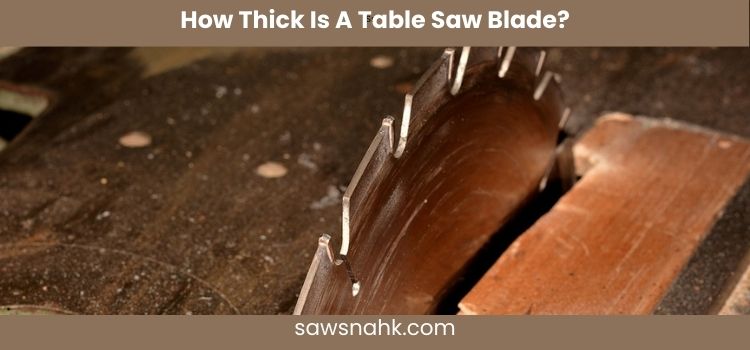How Thick Is A Table Saw Blade? Must Explore this

Table saw blades are an essential part of any woodworker’s workshop, and choosing the right blade for the job can make a big difference in the quality of your work. One of the most important factors to consider is the blade’s thickness.
A table saw blade is a circular blade with sharp teeth used to cut wood. Table saw blades are available in various sizes, thicknesses, and tooth configurations, depending on the woodcut type and the desired cut quality.
Types of table saw blades.
There are two main types of table saw blades: full kerf and thin kerf.
Full kerf blades
Full kerf blades are the most common type of table saw blade. They are thicker, more durable than thin kerf blades, and can handle heavier cuts. However, they also produce a wider kerf and require more power.
Thin kerf blades
Thin kerf blades are thinner and less durable than full kerf blades, but they produce a narrower kerf and require less power. They are good for cutting thin or delicate materials like plywood or veneer.
Thickness of table saw blades.
Standard thickness
The standard thickness for a table saw blade is 1/8 inch for full kerf blades and 3/32 inch for thin kerf blades. However, some thickness variations depend on the blade’s brand and model.
Variations in thickness
Some table saw blades are available in thicknesses other than 1/8 inch and 3/32 inch. For example, some blades are available in 1/4-inch or 5/16-inch thicknesses. You can use these thicker blades for heavy-duty applications like ripping lumber or cutting thick plywood.
How to measure the thickness of a table saw blade.
There are two ways to measure the thickness of a table saw blade: a ruler or a micrometer.
Using a ruler
To measure the thickness of a table saw blade using a ruler, place the ruler on the flat side of the blade and measure the distance from the top of the teeth to the bottom.
Using a micrometer
To measure the thickness of a table saw blade using a micrometer, place the micrometer on the flat side of the blade and close the jaws of the micrometer until they lightly touch the blade. Then, read the thickness of the blade on the micrometer display.
Factors For choosing a table saw blade thickness
Type of wood being cut: ,
Choosing Blade’s thickness depends on the type of wood you are going to cut. You need a thicker blade to cut hard or thick wood and a thinner Blade to cut soft or thin wood.
Desired cut quality:
If you need a very clean cut, you need a thinner blade. You can use a thicker blade without concern about cut quality.
Power of your table saw:
You must use a thinner blade if you have a less powerful table saw. You can use a thicker blade with a more powerful table saw.
Additional factors to consider
In addition to the factors listed above, there are a few other things to keep in mind when choosing a table saw blade thickness:
Noise:
Thinner blades tend to be quieter than thicker blades.
Price:
Thinner blades are typically more expensive than thicker blades.
Availability:
Thinner blades may be more difficult to find than thicker blades, especially in smaller stores.
Tips for choosing and using table saw blades
Here are a few tips for choosing and using table saw blades:
- When choosing a table saw blade, select a blade with the right tooth configuration for the type of wood you are cutting.
- Inspect the blade for any damage before using it. If the blade is damaged, do not use it.
- Make sure to use the correct blade guard and push stick for the type of cut you are making.
- Never force the blade through the wood.
- Be aware of the kickback zone and avoid standing in it.
- Always unplug the table saw before making any adjustments or changing blades.
Conclusion:
Choosing the right table saw blade thickness is crucial for getting the best results from your table saw. The thickness of your table saw blade can affect the cut quality, power requirements, and kerf width.
The standard thickness for a table saw blade is 1/8 inch for full kerf blades and 3/32 inch for thin kerf blades. However, some thickness variations depend on the blade’s brand and model.
You can measure the thickness of a table saw blade using a ruler or a micrometer. When choosing a table saw blade thickness, it is important to consider the type of wood being cut, the desired cut quality and the power of your table saw.
FAQS
How thick is a bandsaw blade kerf?
The kerf of a bandsaw blade can vary depending on the width and thickness of the blade, but it is typically between 1/16 inch and 1/8 inch thick.
Can you kerf a 2×4?
Yes, you can kerf a 2×4 with a bandsaw or a table saw. However, using a blade with the correct tooth configuration is important for the type of wood you are cutting.
How thick is the kerf of a table saw?
The kerf of a table saw blade is typically 1/8 inch thick for full kerf blades and 3/32 inch thick for thin kerf blades.
Can you rip 2×4 on a table saw?
Yes, you can rip a 2×4 on a table saw. However, you must use a blade with the correct tooth configuration for ripping lumber.
Do you need a kerf on a table saw?
Yes, you need a kerf on a table saw to cut wood. The kerf is the width of the material removed by the blade.
